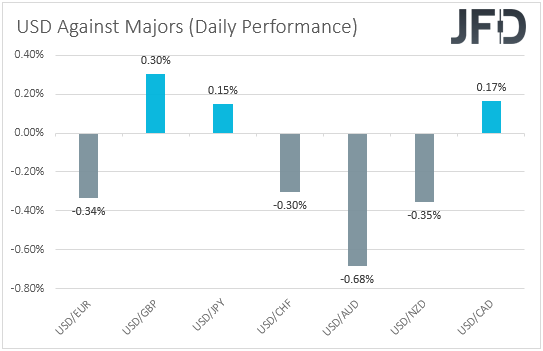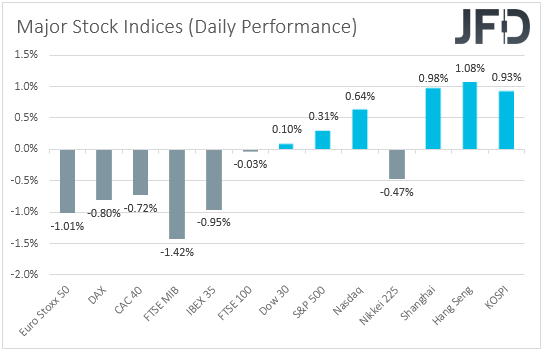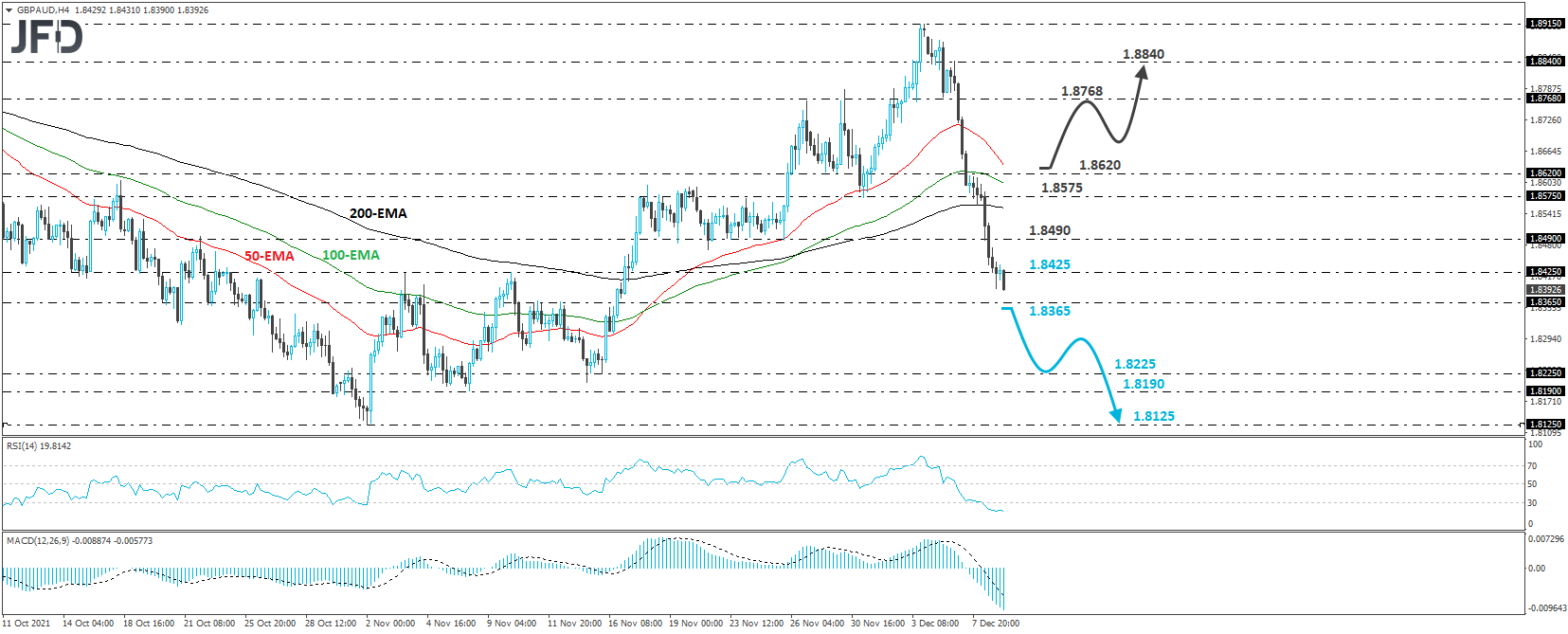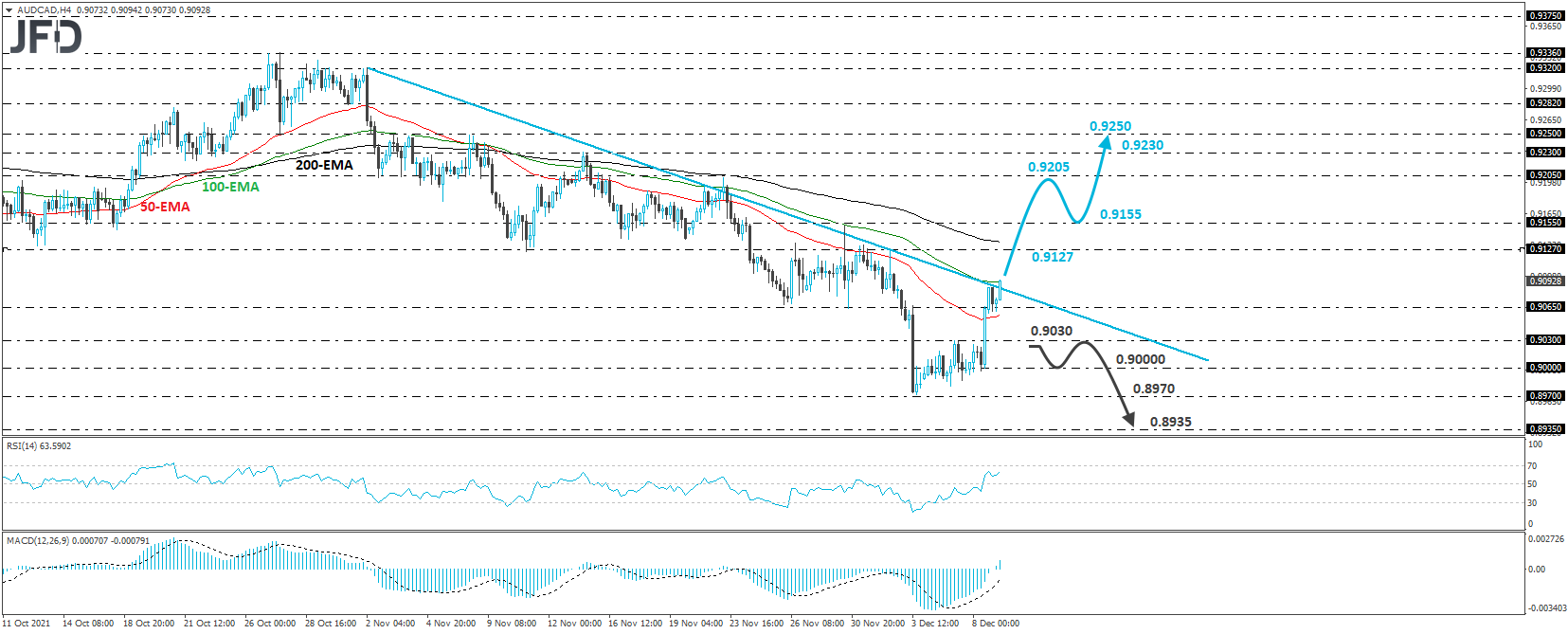EU stocks slid yesterday after UK Prime Minister Boris Johnson announced tougher COVID-related restrictions for his nation. However, sentiment improved again during the US session, perhaps as investors continued to cheer reassuring news over the Omicron variant.
We also had a BoC decision yesterday, with officials keeping interest rates untouched, but sounding more concerned over the coronavirus impact on economic activity.
EU equities slide on new UK measures, BoC concerns on Omicron
The US dollar continued underperforming most of the other major currencies on Wednesday and during the Asian session Thursday. It gained only against GBP, CAD, and JPY in that order, while it lost ground versus AUD, NZD, EUR, and CHF.
The relative weakness of the US dollar and the Japanese yen, combined with the strengthening of the risk-linked {0|Aussie}} and Kiwi, suggests that investors maintained a risk-on mood yesterday and today. However, the weakening of the pound and the Loonie, as well as the relative strength of the franc, point otherwise.
Thus, in order to get a clearer picture with regards to the broader market sentiment, we prefer to turn our gaze to the equity world. There we see that major EU indices traded in negative waters, but sentiment improved during the US session, with all three of Wall Street’s indices closing in the green. The improved appetite rolled over into the Asian session today as well. The only index of those under our radar which slid was Japan’s Nikkei 225.
European investors may have turned cautious yesterday after UK Prime Minister Boris Johnson announced tougher COVID-related restrictions, ordering people to work from home, wear masks in public places and use vaccine passes.
This may have been the catalyst behind the pound’s slide as well. However, the market impact stayed limited to European and UK assets. During the US session, we saw sentiment improving, with investors perhaps still cheering reassuring headlines surrounding the Omicron coronavirus variant.
Remember that studies have shown that the symptoms of this new strain are mild and that a third dose of the Pfizer (NYSE:PFE) vaccine can neutralize it.
Overall, we maintain the view that risk appetite could stay supported for a while more. However, we repeat for the umpteenth time that we are reluctant to call for a long-lasting recovery. Any headlines pointing to more severe symptoms of the Omicron variant, or more restrictions around the globe that could hamper economic activity, are likely to result in stress and anxiety again, and thereby another round of risk-aversion.
Besides news surrounding the coronavirus, we also had a BoC monetary policy decision yesterday, with the Bank keeping interest rates untouched at 0.25%. In the statement accompanying the decision though, the language was more cautious than previously, with officials expressing concerns over the economic impact of the new coronavirus variant.
They acknowledged that the new strain has injected renewed uncertainty and that this uncertainty could weigh on growth by compounding supply-chain disruptions and reducing demand for some services. With CAD-traders perhaps anticipating a rate hike in coming months, such wording may have come as a disappointment, as it means that Canadian policymakers are not in a rush to push the hike button.
That’s why, despite being a risk-linked currency, the Canadian dollar slid at the time of the release. It could feel the heat of the decision for a while more, but we expect its traders to soon turn their gaze to developments surrounding the broader market sentiment.
More optimistic headlines could keep the Loonie slide short-lived and result in a rebound soon. After all, we saw a similar pattern in the Aussie. Despite the RBA being among the central banks that do not want to touch rates in 2022, the Aussie has been the best performer among the major currencies now in the midst of the latest optimism.
GBP/AUD - technical outlook
GBP/AUD has been in a free fall mode since Dec. 3, when it hit resistance at 1.8915. Today, the pair dropped below the 1.8425 hurdle, marked by the inside swing highs of Nov. 3 and 10, and with no signs of the fall slowing down anytime soon, we see the case for the bears to stay in charge for a while more.
We believe that they may test the 1.8365 barrier soon, marked by the inside swing high of Nov. 12, the break of which could carry larger bearish implications, perhaps towards the low of Nov. 16, at 1.8225, or the low of Nov. 8, at 1.8190. If the bears are not willing to stop there either, we could see them pushing towards the low of Nov. 2, at 1.8125.
We will start examining whether the bears have abandoned the action if we see a recovery back above the 1.8620 barrier. This could encourage advances towards the inside swing low of Dec. 6, at 1.8768, the break of which could pave the way towards the peak of Dec. 7, at 1.8847.
AUD/CAD - technical outlook
AUD/CAD traded sharply higher on Wednesday, and today, it managed to briefly overcome the downside resistance line taken from the high of Nov. 2. In our view, this suggests that some further advances may be looming for the near future.
We will get more confident on that front if we see a decisive break above the peak of Dec. 2, at around 0.9127. This could initially target the high of Nov. 30, at 0.9155, the break of which could pave the way towards the high of Nov. 23, at 0.9205. Slightly higher we have two more zones that could act as resistances and those are at 0.9230 and 0.9250, marked by the highs of Nov. 15 and 8, respectively.
On the downside, a break back below 0.9030, marked by the inside swing high of Dec.7, could wake up the bears again. The rate will return below the downside line taken from the high of Nov. 2, and could initially allow declines towards the 0.9000 territory, marked by the low of Dec. 8. A drop lower could aim for the low of Dec. 3, at 0.8970, the break of which is likely to extend the fall towards the low of Apr. 24, 2020, at 0.8935.
As for today's events
The only noteworthy release is the US initial jobless claims for last week, and expectations are for a small decline to 215k from 222k.
As for tomorrow, during the early European session, the UK releases its monthly GDP for October, alongside the industrial and manufacturing production rates for the month.
There is no forecast for the monthly GDP rate, but the yoy rate is anticipated to have jumped to +22.2% from +6.6%. Industrial production is anticipated to have rebounded +0.2% mom after sliding 0.4%, while the manufacturing production rate is forecast to have held steady at +0.1% mom.
Lately, due to fresh coronavirus-related worries, bets around a December hike by the BoE have declined, with most market participants now believing that officials may prefer to wait and act after the turn of the year. This, combined with the pound’s strengthening correlation with risk sentiment, have brought the currency under selling interest.
Although this data is expected to come in on the bright side, we don’t expect it to alter expectations around the BoE’s actions. Investors are already worried that the newly imposed restrictions could weigh on economic activity moving forward.
